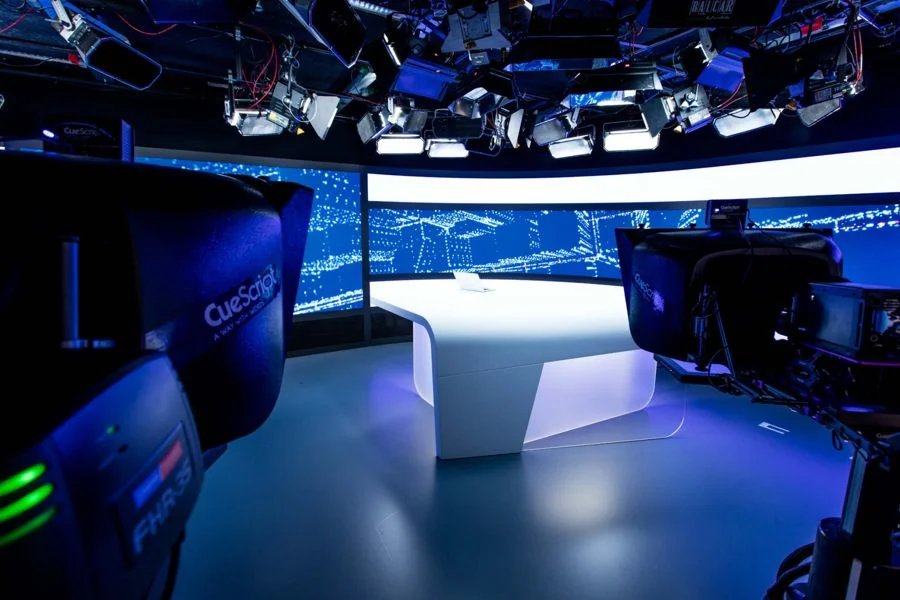A pixel display is the foundation of all digital screens, from smartphones and TVs to LED panels and transparent digital walls. The word pixel comes from "picture element," the smallest unit of a digital image. Each pixel can change color and brightness to form the images we see.
In LED screens, each pixel is composed of three light-emitting diodes: red, green, and blue (RGB). The combination of these diodes allows for the production of millions of color variations. When the pixels light up in different patterns, they create sharp images, animations, and text. The precision of a screen depends on the density with which these pixels are arranged.
How does pixel display technology work?
Each pixel functions like a tiny light bulb. When an electric current passes through them, the RGB diodes emit light. The control system adjusts the brightness of each diode to match the incoming image or video signal.
Pixel displays utilize various integrated driver circuits and control systems to synchronize millions of LEDs. Modern LED displays can achieve refresh rates exceeding 3840 Hz, allowing for smooth, flicker-free playback, even in slow-motion videos or camera recordings. Brightness levels can exceed 5000 to 8000 nits in models for outdoor use, ensuring visibility even in direct sunlight.
The LED module, power supply, and receiver board work together to maintain accurate color calibration and uniform brightness across the entire screen.
Different types of Pixel Displays
1. LED Pixel Display
The most common type of screen. Each pixel is an independent light-emitting diode, meaning there is no need for backlighting, making it suitable for both indoor and outdoor use.
2. LCD Pixel Display
It uses liquid crystals controlled by an electric field and illuminated by a backlight. It is common in TVs and monitors where precise image control is required.
3. OLED Pixel Display
Each pixel produces its own light. This allows for true blacks, deep contrast, and flexible screen designs, often used in premium phones and TVs.
4. MicroLED Pixel Display
An advanced version of LED technology. It uses microscopic LEDs that improve brightness and lifespan while reducing energy consumption.
5. Transparent Pixel Display
Constructed with transparent LED film or glass panels. Ideal for shop windows, museums and architecture, advertising and natural visibility.
Important specifications to consider
When evaluating the display pixels, Go beyond just resolution. These factors define real-world performance:
- Shine: Indoor screens range from 800 to 1500 nits; outdoor screens from 5000 to 10,000 nits.
- Refresh rate: Minimum of 1920 Hz for general use; 3850 Hz or higher for professional transmission.
- Contrast ratio: High contrast ensures vibrant colors even in ambient light.
- Grayscale: A higher grayscale resolution (14-16 bits) produces smoother images.
- Viewing angle: Wide viewing angles (140° or more) maintain color uniformity at all angles.
- Energy consumption: Average of 200-300 W/m² for indoor screens; up to 500 W/m² for outdoor screens.
- Durability: IP31-IP67 ratings offer protection against dust and moisture, depending on the environment.
Pixel Display Applications
Display pixels are widely used in various industries and environments.
1. Retail trade and shopping centers
Stores use LED screens to display digital advertisements and promotions on glass walls and inside showrooms. The transparent LED screens create attractive visual effects without blocking the passage of light.
2. Pixel Displays for Transportation and Public Areas
Airports, bus terminals, and train stations use LED panels with pixels to display real-time information, announcements, and safety messages.
3. Pixel displays for sports and events
The stadiums use large-format LED electronic scoreboards and perimeter screens to display live scores and sponsored content.
4. Display screens for transmission and control rooms.
High-resolution LED panels display data and images from cameras in real time, with minimal delay and excellent color accuracy.

5. Corporate and educational pixel displays
Companies and schools use small-pitch LED displays for presentations, virtual meetings, and digital classrooms.
6. Architecture and art in pixel displays
Pixel displays integrated into the facades of buildings or museums create interactive and aesthetic lighting effects.
Why is pixel density important?
Pixel density, often expressed in PPI (pixels per inch), affects the level of detail in images. The higher the density, the smoother the image. Screens with low pixel density may exhibit visible gaps between pixels, known as the "mosquito net effect".
For applications that require close-up viewing, such as store displays or studios, a high pixel density is essential to achieve realistic and professional results.
Maintenance and Longevity
Modern LED panels with pixels are designed to last 50,000 to 100,000 hours. Regular maintenance helps extend their lifespan.
- Keep ventilation openings unobstructed to prevent heat buildup.
- Avoid exposing non-waterproof screens to moisture.
- Calibrate the colors periodically to obtain a consistent output.
- Use surge protection to ensure a stable power supply.
Modular designs allow for quick replacement of individual panels, reducing downtime and maintenance costs.
The future of pixel displays
Emerging technologies such as Mini LED and MicroLED are setting new standards in brightness and pixel control. These displays offer greater efficiency, thinner panels, and increased flexibility, making them ideal for curved or transparent installations.
With the growing demand for immersive, high-definition visual experiences, pixel displays are becoming smarter, thinner, and more efficient than ever before.
Conclusion
A pixel display is more than just a collection of lights; it's a precise system that brings images to life through millions of tiny light sources. Understanding how pixel spacing, brightness, and density work helps you choose the right display for your needs.
Whether for a internal video panel, Whether it's an outdoor billboard or a transparent retail screen, the right setup ensures vibrant colors, smooth performance, and durability.
